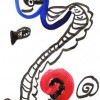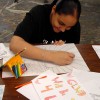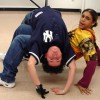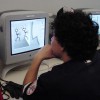- Keith Haring Murals in San Sebastián
- Keith Haring Murals
- Come To Know Keith Haring
- Organ Systems Mural
- City as Canvas: Artist Spotlight
- Printing with Objects
- Mural Making in the Style Of Keith Haring
- Subway Graffiti Project
- T-shirt Designer
- Keith Haring Semiotics Poster
- Introducing Keith Haring
- Discovering Keith Haring
- Haring Inspired Mural
- All Bottled Up!
- Thinking about Drawings as Symbols
Mural to Music 1
Ask your students to make a collaborative mural drawing to music, using their invented sign language, their imagination, and their responses to the music.
Hip Hop, Skip, and Jump
This program was designed to be a take-home activity for children in conjunction with the exhibition of Keith Haring's work at the Whitney Museum in New York City.
Tools for Discussing Haring’s Work
By maintaining a framework to lead a discussion, this outline will help make looking at, talking about, and responding to art less intimidating.
The 1980s Series – Graffiti
During the 1980s, music, dance, fashion, and art experienced a boom of energy and innovation. It was also during the 80s that Haring came into prominence and produced most of his signature work. This series of lessons seeks to explore the cultural and creative phenomenons of the 1980s for the youth of today. The Graffiti project seeks to create an open & constructive forum for students to communicate their thoughts and feelings by creating a "graffiti wall" within the classroom.
The 1980s Series – Fashion
During the 1980s, music, dance, fashion, and art experienced a boom of energy and innovation. It was also during the 80s that Haring came into prominence and produced most of his signature work. This series of lessons seeks to explore the cultural and creative phenomenons of the 1980s for the youth of today. The Fashion lesson allows students to transform old clothes, model them and reflect on the process while having fun and being creative.
Everyday Objects as Art
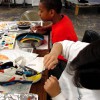
After examining "readymade" artwork by several influential 20th Century artists, these high school students created sculptures by painting on "everyday objects". Offering both an art history and an art-making component, this lesson allows students to analyze and synthesize the creative process for themselves.
Windows
Students can create their own symbolic windows into their imaginations.
